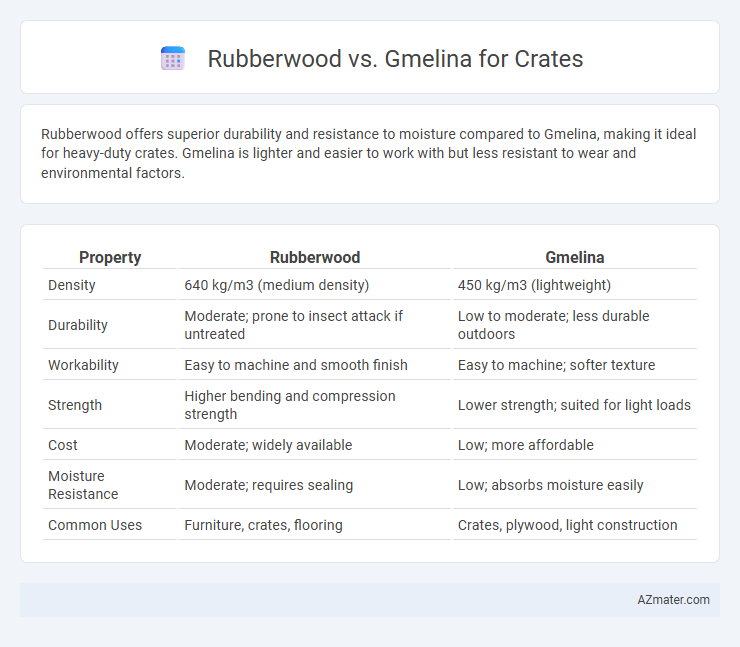Rubberwood offers superior durability and resistance to moisture compared to Gmelina, making it ideal for heavy-duty crates. Gmelina is lighter and easier to work with but less resistant to wear and environmental factors.
Table of Comparison
| Property | Rubberwood | Gmelina |
|---|---|---|
| Density | 640 kg/m3 (medium density) | 450 kg/m3 (lightweight) |
| Durability | Moderate; prone to insect attack if untreated | Low to moderate; less durable outdoors |
| Workability | Easy to machine and smooth finish | Easy to machine; softer texture |
| Strength | Higher bending and compression strength | Lower strength; suited for light loads |
| Cost | Moderate; widely available | Low; more affordable |
| Moisture Resistance | Moderate; requires sealing | Low; absorbs moisture easily |
| Common Uses | Furniture, crates, flooring | Crates, plywood, light construction |
Introduction to Rubberwood and Gmelina
Rubberwood, derived from the Para rubber tree (Hevea brasiliensis), is prized for its durability, light color, and eco-friendly nature as it repurposes rubber trees after latex production. Gmelina, sourced from Gmelina arborea, offers a fast-growing, lightweight hardwood option highly valued for its workability and resistance to decay in crate manufacturing. Both woods are popular in packaging industries, but Rubberwood's density and strength make it ideal for heavy-duty crates, while Gmelina's lighter weight suits transport efficiency and ease of handling.
Botanical Overview: Rubberwood vs Gmelina
Rubberwood (Hevea brasiliensis) is a hardwood from the Euphorbiaceae family known for its dense, durable grain, commonly used in furniture and crates due to its strength and resistance to impact. Gmelina (Gmelina arborea), belonging to the Lamiaceae family, features a lighter, softer timber with moderate durability, often favored for lightweight crate construction and ease of workability. Both species offer sustainability benefits, with Rubberwood sourced from plantation trees post latex production and Gmelina harvested from fast-growing forestry plantations.
Wood Strength and Durability Comparison
Rubberwood offers moderate strength and durability with a Janka hardness rating around 980, making it suitable for lightweight crates and moderate load-bearing. Gmelina wood, with a softer texture and a Janka hardness of approximately 550, has lower strength but dries quickly, which can reduce warping in crate construction. For applications requiring higher resistance to wear and impact, Rubberwood is preferred, while Gmelina is better suited for lightweight, quick-turnaround crates.
Workability and Machinability
Rubberwood offers excellent workability due to its uniform grain and moderate hardness, making it easy to saw, nail, and glue when constructing crates. Gmelina, being softer and less dense, provides superior machinability with less wear on cutting tools, allowing for faster processing and smooth finishing. Both woods are suitable for crate manufacturing, but Rubberwood's strength and Gmelina's ease of machining make each ideal depending on production priorities.
Weight and Density Differences
Rubberwood has a higher density of approximately 560-640 kg/m3, making it heavier and more durable than Gmelina, which typically has a density around 340-420 kg/m3. This weight difference influences crate strength, with Rubberwood crates offering better load-bearing capacity and resistance to impact. Gmelina's lighter weight makes it easier to handle and transport but may compromise durability in heavy-duty applications.
Cost and Availability Analysis
Rubberwood offers a cost-effective solution for crates due to its abundance as a byproduct of rubber plantations, ensuring steady availability and lower market prices compared to Gmelina. Gmelina, while valued for its lighter weight and ease of machining, often commands higher prices owing to slower growth rates and limited regional supply. Choosing Rubberwood optimizes budget constraints and supply reliability for bulk crate production in commercial sectors.
Sustainability and Environmental Impact
Rubberwood, sourced from aged rubber trees after latex extraction, offers a sustainable solution by repurposing plantation wood that would otherwise be discarded, reducing deforestation. Gmelina, a fast-growing hardwood native to Asia, contributes to sustainability through rapid biomass regeneration and efficient carbon sequestration in agroforestry systems. Both woods have low environmental footprints compared to tropical hardwoods, but Rubberwood's use of plantation waste wood makes it particularly eco-friendly for crate manufacturing.
Pest and Decay Resistance
Rubberwood offers moderate pest resistance but is more susceptible to decay without proper treatment, making it less ideal for long-term crate durability in humid environments. Gmelina exhibits better natural resistance to pests and decay, providing enhanced longevity and structural integrity for crates exposed to varying weather conditions. Selecting Gmelina over Rubberwood can reduce maintenance costs and increase crate lifespan due to its superior durability against biological threats.
Finishing and Aesthetic Appeal
Rubberwood offers a smooth, fine grain that absorbs finishes evenly, resulting in a polished and uniform appearance ideal for crates requiring a clean, professional look. Gmelina features a lighter color with a coarser texture, which can create a more rustic or natural aesthetic but may require additional sanding for a smooth finish. Both woods accept stains and varnishes well, but Rubberwood's tighter grain enhances color richness and durability in finished crates.
Best Choice for Crates: Rubberwood or Gmelina?
Rubberwood offers superior durability and resistance to impact, making it the best choice for heavy-duty crates requiring long-term strength and stability. Gmelina is lightweight and cost-effective but less dense and more prone to wear, which suits crates for lighter loads or short-term use. For crates demanding robustness and longevity, rubberwood is the optimal material due to its dense grain structure and natural resilience.

Infographic: Rubberwood vs Gmelina for Crate
 azmater.com
azmater.com